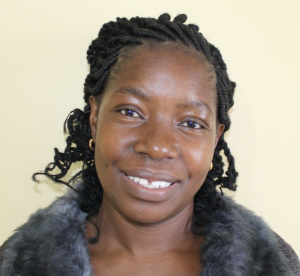"When I was posted to this school in January this year, I was saddened by the lack of sufficient water, the poor state of sanitation facilities, and poor hygiene practices," said Kerongo Secondary School Principal Mrs. Medrine Ludenyi.
"I wished I could solve these issues immediately but my hands were tied due to lack of funds. Now that we have found help from [you] we thank God for answering our prayers and thanks to the organization for considering us."
"Enrollment has been slow since we lack [a] conducive environment for learning. The rates of absenteeism and school dropouts are also high because of water-related diseases and lack of proper sanitation. With this project implementation, I believe the school population will grow and there will be improved hygiene practices since we will have sufficient water for cleaning, cooking, and drinking."
Many students at Kerongo Secondary School walk for more than a mile to get to school, which means that for security reasons, the school had to adjust its arrival time from 6:30 am to 7:00 am. This was because some students would be attacked on their way to school when they started their journey in darkness.
Why such an early start?
Cleaning the classrooms and the compound at Kerongo Secondary starts as soon as students arrive, which is the only chore required before arguably the most important one of the day - when students go to the spring for the first time that day to fetch water.
The spring is quite a distance from the school - about 1.5 kilometers - yet students must make several trips across the hilly and rocky area to fetch water every day. By the time they settle into class to start learning, they are already tired which affects their studies negatively. To get to the spring, students have to cross through the bush and across a busy road where motorcycles pass frequently, putting them at risk of being hurt in a collision.
The spring is accessible but overcrowded, especially in the mornings when community members go in large numbers to the spring to get water for family use. This results in students spending more time at the spring as they wait their turn, sometimes even missing their lessons just to get their first jerrycan of water. The containers they use to fetch water are visibly dirty, and they do not treat their water. Back at school, water is stored in the containers it is fetched in. There are no larger rain tanks or storage basins on site.
Students often get sick with water- and hygiene-related illnesses, forcing them to miss valuable class time and requiring their parents to spend what little money they have on hospital bills instead of on other important family needs.
Once they are done at the spring in the morning, students must hurry back to school as classes start at 8:00 am and go to 12:45 pm with 2 breaks in between to allow students to use the latrines and take mid-morning tea. During lunchtime, they take their meal very fast so that they can go back to the spring to fetch more water. The afternoon lessons resume from 2:00 pm to 4:00 pm. Pupils then play in the field for 30 minutes before going back to class for evening preps until 5:40 pm when they leave for home.
Kerongo Secondary School is a public mixed-gender secondary school that was established in 1985 by Mr. Burton Bulima, who was also the school's first principal. It has gradually grown from 22 pupils to the present-day population of 267 students, 20 teachers, and 6 staff, yet it continues to face a severe clean water shortage.
There are separate latrines at Kergono Secondary for the girls, boys, and adults, but though they seem to be in good condition from the outside due to their paint, a closer look inside tells a different story.
"The available latrines were built a long time ago and they are almost full. We try to wash them on a daily basis but we use little water because the water we fetch from the spring has to be used sparingly. We don't wash our hands after using the latrines which results in students suffering from diarrhea and typhoid," said 15-year-old student Edwin Oranja.
Kerongo village where the school is located is a peaceful, rural area surrounded by beautiful scenery comprised of granite rocks, stones, and trees. It is next to the tourist attractions Mungoma Caves and Maragoli Hills. People in this area grow maize, vegetables, groundnuts, bananas, and sweet potatoes on a small scale. They also rear cattle, goats, sheep, and chickens. Most buildings are mudwalled and iron sheet-roofed and they are close to each other since each family owns small pieces of land.
What we can do:
Rain Tank
A 50,000-liter rainwater catchment tank will help alleviate the water crisis at this school. The school will help collect the needed construction materials such as sand, bricks, rocks, and water for mixing cement. We will complement their materials by providing an expert artisan, tools, hardware, and the guttering system. Once finished, this tank will begin catching rainfall that will be used by the school’s students and staff for drinking, handwashing, cooking, cleaning, and much more.
We and the school strongly believe that all of these components will work together to improve standards at this school, which will help lead to better student academic performance and will help unlock the opportunity for these students to live better healthier lives.
Handwashing Stations
There are currently some handwashing stations for students to wash their hands after using the latrines or before eating lunch, but they do not all have soap or ash. This, combined with the little water afforded to the handwashing stations, means students' hands are not getting cleaned at critical points in their day.
The student health club will oversee the addition of 2 new handwashing stations we will provide, and make sure they are kept clean and in working condition. The club leaders will fill the handwashing stations with water daily and make sure they are always supplied with a cleaning agent such as soap or ash.
VIP Latrines
2 triple-door latrines will be constructed with local materials that the school will help gather. 3 doors will serve the girls while the other 3 will serve the boys. All of these new latrines will have cement floors that are designed to be easy to use and to clean. And with a rain tank right on school property, there should be enough water to keep them clean.
Training
We will hold training on improved hygiene, health, and sanitation habits for 2 days at this school. Our team of facilitators will use a variety of methods to train students and staff, including participatory hygiene and sanitation transformation (PHAST) and asset-based community development (ABCD). We will initiate a child-to-child (CTC) health club, which will prepare students to lead other students into healthy habits at school and at home. We will also lead lectures, group discussions, and provide illustrative handouts to teach health topics and ways to promote good hygiene practices within the school.

 Rainwater Catchment
Rainwater Catchment
 Rehabilitation Project
Rehabilitation Project




































